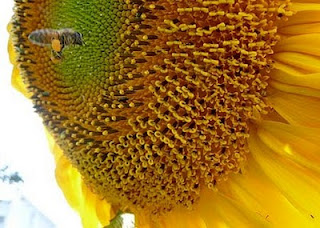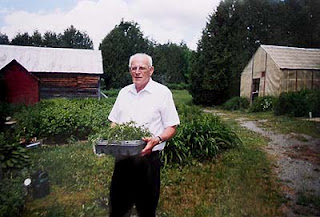Across the land, beekeepers are now bringing their honey to the honey house for extracting. One of the miracles of working on the land and with the bees took place again this year. A lot of honey came in the last few days. We saw it in our own bees: right into last week, the crop was light. The bees had months of rain this season, day after day of precipitation where they stayed in their homes and did not fly to flowers.

Ann D. Watson Aug. 29, 2008
Then came the goldenrod and aster flowers, the last major and minor nectar plants of the season in the northeast. Many beekeepers commented about how they had looked at the hives before this, and they were “light”. But after the goldenrod and aster bloomed, the next time they were with their bees, there was a good crop.
This has happened with our bees many times over the last 30 years, which has helped me have more patience and trust in the whole process of the rhythms of the land. At the “eleventh hour” you can’t do much about the strength or health of your bees anyway, and we see how in letting go and accepting, we are often given great abundance.
Sunflowers heads are composite flowers. The head looks like one flower, but like the dandelion, the sunflower is actually composed of numerous small florets. A sunflower head like this is composed of 1,000 to 4,000 florets. Each floret contains both male and female parts of the flower and is open for 2 days to be pollinated. Honey bees collect both pollen and nectar from sunflowers.
Florets open from the outer edge of the flower head inwards, so one can see gradual progression as pollination occurs. It takes 5 – 10 days for this process to be completed.
source: Crop Pollination by Bees by Keith S. Delapland and Daniel F. Meyer. Published by CABI Publishing, 2000.

Greensboro, Vermont, June 2003
Lewis Hill, a gentle giant, teacher & friend, a man of the plants, 1924 – 2008
I met Lewis when I was fresh out of agricultural school; I was the state bee inspector and checked in with him each year to see how his bees were going. I was drawn to this giant of a man, who was among the most gentle and kind of people I had ever met. He was evidence that people are put in our paths to dramatically change and improve our lives.
For years as we walked around the gardens where he and Nancy lived, as well as his father and grandfather before him, he pointed out the medicinal plants as elecampagne, the many varieties of lilies, berries, apples, and vegetables that he and Nancy grew. Lewis delighted in introducing me to the elderberries and black currants, and would share the medicinal value of each. After the walks, there was often a cocktail of elderberry and orange juice.
“Todd, why don’t you consider working with elderberry”, he would ask me each year, as we walked among the towering plants. I listened, but was so focused on the bees that I did not digest what he was saying. Lewis gave me plants to take home, always looking for and finding a small one that could be transplanted and moved in any month of the year. After 14 years of his mantra, I started to see elderberry products in health food stores, which came from Europe and were mixed with glucose, fillers, and artificial ingredients. It was easy to see that we could produce something of a higher quality here in Vermont, and make it with raw honey. I went back to Lewis and said that I now understood what he was saying, and asked for more information. He smiled and simply said that he had been waiting for me to hear and listen. Then he took me to his library and he shared files from articles, written over the years, on the elderberry’s medicinal value and propagation.
We then started the Vermont Elderberry Project. For years Lewis would fill his greenhouse with softwood elderberry cuttings. I would pick them up in the summer after they had rooted, and shared them with thousands in our community and beyond. Lewis connected us to another era, where outside the Vermont farmhouse, people would grow elderberry and have bees and chickens.
Elderberry is older than Vermont; it has the anti-viral agent that chemical medicines do not have for getting rid of the virus in the common cold. It supports the immune system and is helpful when one has the flu.
If it were not for Lewis sharing the elderberry, we would not be keeping bees and sharing Apitherapy honey around this land. The elderberry gave our apiary an opportunity to diversify and share the value of honey as a medicine in plant medicine.
While Lewis was a man of great strength, he always showed me great kindness and tenderness. He was not shy about showing his affections, being one of the first in my work to sign each letter “love, Lewis”. As soon as I “got it” about the elderberry, he started taking me to the black currant plants and putting these in my car to take home and think about. I understood it earlier this time, and we are now making black currant honey wine, and looking at a new plant medicine with black currant.
At the honey house of Honey Gardens, we are the caretakers for two elderberry cultivars of Lewis Hill, Berry Hill and Coomer; he always said that they produce larger berries and are more winter hardy. From this plantation, we make hardwood and softwood cuttings, and share these each year. ‘Plant 6 – 20 feet apart, have at least one of each cultivar for greater pollination and fruit yield, and protect your plants from the deer.”
Thank you, Lewis. We see the fruit of your life all around us.